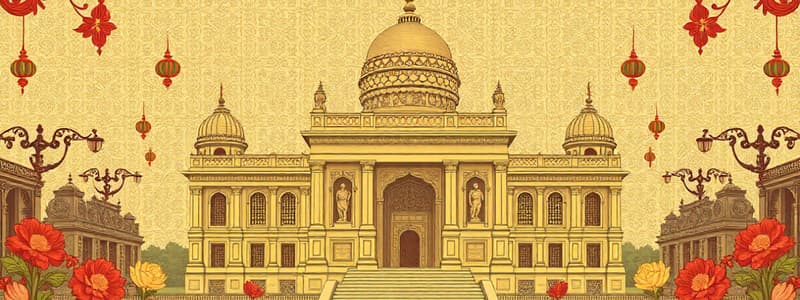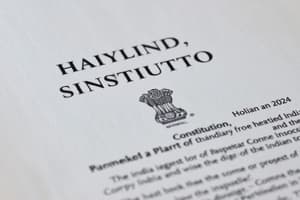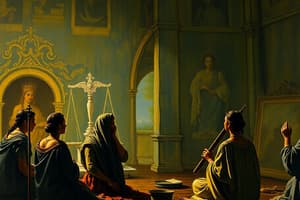Podcast
Questions and Answers
Which concept underpins the treatment of all religions equally by the state?
Which concept underpins the treatment of all religions equally by the state?
- Secularism (correct)
- Affirmative Action
- Social Justice
- Federalism
What is the primary focus of the Directive Principles of State Policy?
What is the primary focus of the Directive Principles of State Policy?
- Maintaining law and order
- Promoting competitive federalism
- Regulating powers between central and state governments
- Guidelines for social and economic welfare (correct)
Which articles provided a special status to Jammu and Kashmir that was abrogated in 2019?
Which articles provided a special status to Jammu and Kashmir that was abrogated in 2019?
- Articles 245 & 246
- Articles 256 & 257
- Articles 20 & 21
- Articles 370 & 35A (correct)
What is the primary objective of affirmative actions related to Scheduled Castes and Scheduled Tribes?
What is the primary objective of affirmative actions related to Scheduled Castes and Scheduled Tribes?
Which principle involves the distribution of powers between central and state governments?
Which principle involves the distribution of powers between central and state governments?
Which of the following statements accurately describes the structure of the Parliament in India?
Which of the following statements accurately describes the structure of the Parliament in India?
What is the role of the President in the Indian political system?
What is the role of the President in the Indian political system?
Which of the following is NOT considered a Fundamental Duty as per the Indian Constitution?
Which of the following is NOT considered a Fundamental Duty as per the Indian Constitution?
Which of the following best characterizes the political parties in India?
Which of the following best characterizes the political parties in India?
What electoral system is primarily used for Lok Sabha elections in India?
What electoral system is primarily used for Lok Sabha elections in India?
Which article of the Indian Constitution outlines the amendment process?
Which article of the Indian Constitution outlines the amendment process?
In the context of Center-State relations, what does the Concurrent List entail?
In the context of Center-State relations, what does the Concurrent List entail?
What does the Panchayati Raj System refer to within the Indian governance framework?
What does the Panchayati Raj System refer to within the Indian governance framework?
Flashcards are hidden until you start studying
Study Notes
Indian Polity
Constitution of India
- Supreme Law: Governs the country and establishes the framework for political principles.
- Enacted: 26th January 1950.
- Parts: 22 parts, with 448 articles and 12 schedules.
- Fundamental Rights: Guarantees individual rights; includes right to equality, freedom, protection against exploitation, and cultural and educational rights.
Structure of Government
- Parliament: Bicameral legislature consisting of:
- Lok Sabha (House of the People): Lower house; members are directly elected.
- Rajya Sabha (Council of States): Upper house; members are elected by state legislatures and the President.
- Executive:
- President: Constitutional head; elected indirectly by an electoral college.
- Prime Minister: Head of government; leader of the majority party in Lok Sabha.
- Council of Ministers: Aids the President and Prime Minister in governance.
- Judiciary:
- Supreme Court: Apex court; oversees the Constitution and resolves disputes.
- High Courts: Jurisdiction over states; handles appeals from lower courts.
Fundamental Duties
- Enshrined in Article 51A of the constitution; duties include:
- Abiding by the Constitution.
- Promoting harmony.
- Safeguarding public property.
Political Parties
- National Parties: Recognized by the Election Commission; e.g., BJP, Congress.
- State Parties: Operate primarily in one state; recognized based on specific criteria.
- Single-issue Parties: Focused on a particular issue; e.g., environmentalism.
Elections in India
- Electoral System: Mainly first-past-the-post system for Lok Sabha and State Assemblies.
- Election Commission: Constitutional authority responsible for administering elections.
- Voter Eligibility: Indian citizens aged 18 and above can vote.
Center-State Relations
- Distribution of Powers: Division between central and state governments as per the Constitution’s Seventh Schedule.
- Concurrent List: Matters where both levels can legislate; e.g., education, marriage.
Amendments to the Constitution
- Amendment Process: Set out in Article 368; requires varying levels of majority for different types of amendments.
- Notable Amendments: 42nd (1976), 73rd and 74th (1992).
Local Governance
- Panchayati Raj System: Grassroots governance structure; three tiers — village, block, and district levels.
- Urban Local Bodies: Municipalities and Municipal Corporations manage urban areas.
Special Provisions
- Scheduled Castes and Scheduled Tribes: Affirmative actions and reservations in education and government jobs.
- Articles 370 & 35A: Provided special status to Jammu and Kashmir (abrogated in 2019).
Socio-Economic Rights
- Directive Principles of State Policy: Guidelines for the state in governance; aims at social and economic welfare (Article 36-51).
Important Concepts
- Secularism: The state treats all religions equally.
- Federalism: Distribution of powers between central and state governments.
- Social Justice: Ensuring fair treatment and opportunity for all citizens.
These notes cover the foundational elements of Indian polity, focusing on its structure, principles, and functioning.
Constitution of India
- Supreme legal document governing India, establishing its political framework
- Enacted on January 26th, 1950
- Comprised of 22 parts, 448 articles, and 12 schedules
- Guarantees Fundamental Rights, including equality, freedom, protection against exploitation, and cultural and educational rights
Structure of Government
- Parliament: India's bicameral legislature is responsible for lawmaking
- Lok Sabha (House of the People): The lower house, with members directly elected by the people
- Rajya Sabha (Council of States): The upper house, with members elected by state legislatures and the President
- Executive: Implements and enforces laws passed by Parliament
- President: The ceremonial head of state, elected indirectly by an electoral college
- Prime Minister: The head of government, leading the party with the majority in Lok Sabha
- Council of Ministers: Advises the President and Prime Minister, handling governance
- Judiciary: Interprets the law, ensuring its adherence to the Constitution
- Supreme Court: The highest court in India, responsible for resolving legal disputes and overseeing the Constitution
- High Courts: Handle appeals from lower courts and exercise jurisdiction over specific states
Fundamental Duties
- Outlined in Article 51A, these are moral obligations expected of every citizen
- Upholding the Constitution and its principles
- Promoting harmony and national integration
- Safeguarding public property and resources
Political Parties
- National Parties: Recognized by the Election Commission and operate throughout India, such as the Bharatiya Janata Party (BJP) and the Indian National Congress
- State Parties: Primarily operate in one state, fulfilling specific criteria for recognition
- Single-issue Parties: Focus on a particular cause, such as environmentalism, and often emerge during specific political contexts
Elections in India
- Electoral system: Primarily based on the first-past-the-post system for Lok Sabha and State Assemblies
- Election Commission: An independent constitutional body responsible for administering elections
- Voter eligibility: All Indian citizens who are 18 years or older are eligible to vote
Center-State Relations
- Distribution of powers: The Constitution’s Seventh Schedule divides powers between the central government and state governments
- Concurrent List: Areas where both central and state governments can legislate, such as education and marriage
Amendments to the Constitution
- Amendment process: Article 368 outlines the procedures requiring varying levels of majority for different types of amendments
- Notable Amendments:
- 42nd Amendment (1976): Introduced significant changes including fundamental duties and a socialist framework
- 73rd and 74th Amendments (1992): Established the Panchayati Raj (rural governance) and the urban local bodies (municipalities and corporations)
Local Governance
- Panchayati Raj System: A three-tier system (village, block, and district) aimed at decentralizing power and promoting grassroots democracy
- Urban Local Bodies: Municipalities and Municipal Corporations manage urban areas, responsible for providing essential services and infrastructure
Special Provisions
- Scheduled Castes and Scheduled Tribes: Affirmative actions and reservations are implemented in education and government jobs to address historical inequalities
- Articles 370 & 35A: Previously granted special status to Jammu and Kashmir, which was abrogated in 2019
Socio-Economic Rights
- Directive Principles of State Policy: Non-enforceable guidelines for the state, aiming to promote social and economic welfare outlined in Articles 36-51
Important Concepts
- Secularism: The state maintains neutrality towards all religions, ensuring equal treatment
- Federalism: The division of powers between the central and state governments, each holding specific areas of jurisdiction
- Social Justice: Striving for fairness and equity in access to opportunities and resources for all citizens
Studying That Suits You
Use AI to generate personalized quizzes and flashcards to suit your learning preferences.




